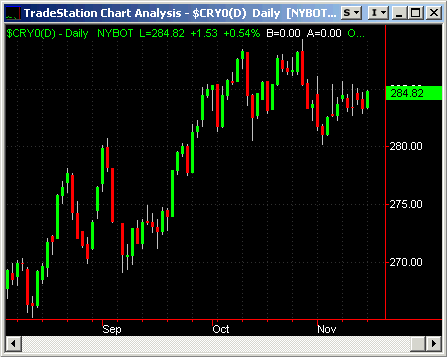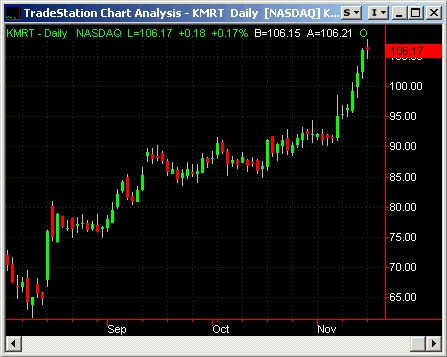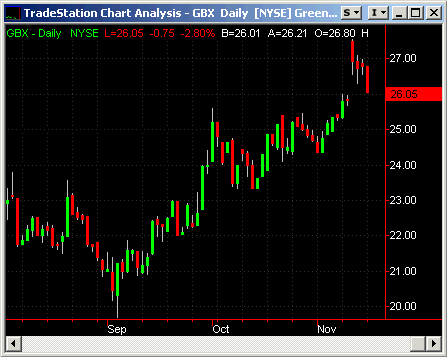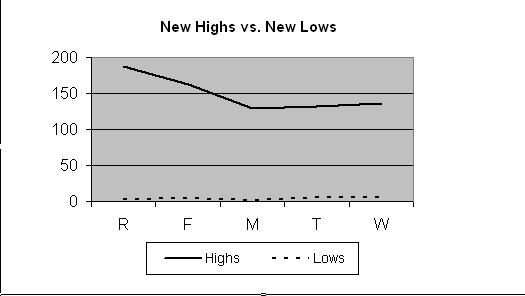It’s A Bull, But Not The ’80s Or ’90s Kind
Roadblocks Receding
The primary roadblocks to the
bull market that took off in 2003 came when the dollar started to correct, bonds
started falling in response to inflation fears, and oil prices started to rise
substantially. Election instability didn’t help either. The correction in
global equities continued through most of the year. However the roadblocks that
led to the market correction are all receding now. The election is over without
a terrorist attack on US soil. The dollar correction is over and the dollar is
declining to new lows. Bonds have acted as an absorber during the correction
and long-rates have eased substantially and remain OK. Bonds shouldn’t be a
problem for the market until long rates rise above around 5%, and that’s a ways
off. Oil prices exploded and are now falling off again, and look set to either
trading range or decline further if this week’s lows are taken out.
That means all systems go for
the market for the short-term at least. Remember that the US market is
underperforming substantially and foreign markets remain the strongest. We
still like Rails, South Africa, Chile, Eastern Europe and non-oil Russia,
Software, Belgium and Austria,
value/growth and mid-cap value, Europe and world/US, Indonesia, Malaysia, and
gold.


The markets
are moving up nicely and breadth is improving. This is the best season for bull
markets as well. However investors should realize that while we want to
participate in this bull leg, it is unlikely to be the 80’s or 90’s kind of bull
market.  This one might move the S&P to the 1200-1350 area. While it does so,
investors can exploit top countries, sectors, and stocks to substantial
advantage. But keep one finger on the exit trigger. This market and global
economy are built on very fragile stuff. If the economy starts to reaccelerate,
long-rates will move up sharply and swiftly again and rate tightening and higher
rates across the board will kill the move. And if the economy turns down again
we have deflationary risks faster than you can imagine. Participate, but remain
flexible.
^next^
We continue to expect that
investors will have to stay very nimble and watchful to make decent returns and
avoid the potential pitfalls during this historic period, though a slightly
better period may be here for a quarter or two. We will continue to try to
understand and profit from the environment whatever it is and whatever
develops. We continue to strongly believe now more than ever that investors
must monitor global trends in a wide variety of asset-classes to be able to
profit strongly from the major waves that are developing.
Our model portfolio followed in
TradingMarkets.com with specific entry/exit/ops levels from 1999 through May of
2003 was up 41% in 1999, 82% in 2000, 16.5% in 2001, 7.58% in 2002, and we
stopped specific recommendations up around 5% in May 2003 (strict following of
our US only methodologies should have had portfolios up 17% for the year 2003) —
all on worst drawdown of under 7%.  This did not include our foreign stock
recommendations that had spectacular performance in 2003.Â
This week in our Top RS/EPS New Highs list published on TradingMarkets.com, we
had readings of 187, 162, 129, 132, and 136 with 77 breakouts of 4+ week ranges,
valid trades in KMRT and GBX and no close calls. Breadth is expanding again and
more close calls would be a call to add some long exposure. Position in valid
4+ week trading range breakouts on stocks meeting our criteria or in close calls
that are in clearly leading industries, in a diversified fashion. This week,
our bottom RS/EPS New Lows recorded readings of 3, 4, 2, 5, and 5 with 6
breakdowns of 4+ week ranges, no valid trades and no close calls. We’re seeing
a growing number of valid breakouts, though this is not a gung-ho environment.Â
Valid signals are in place in CETV, MLI, VIP, KMRT and GBX. The rally is
picking up and so is our allocation.


For those not familiar with our long/short strategies, we suggest you review my
book
The Hedge Fund Edge, my course “The
Science of Trading,”
my video seminar, where I discuss many
new techniques, and my latest educational product, the
interactive training module. Basically,
we have rigorous criteria for potential long stocks that we call “up-fuel,” as
well as rigorous criteria for potential short stocks that we call “down-fuel.”
Each day we review the list of new highs on our “Top RS and EPS New High List”
published on TradingMarkets.com for breakouts of four-week or longer flags, or
of valid cup-and-handles of more than four weeks. Buy trades are taken only on
valid breakouts of stocks that also meet our up-fuel criteria. Shorts are
similarly taken only in stocks meeting our down-fuel criteria that have valid
breakdowns of four-plus-week flags or cup and handles on the downside. In the
U.S. market, continue to only buy or short stocks in leading or lagging
industries according to our group and sub-group new high and low lists. We
continue to buy new long signals and sell short new short signals until our
portfolio is 100% long and 100% short (less aggressive investors stop at 50%
long and 50% short). In early March of 2000, we took half-profits on nearly all
positions and lightened up considerably as a sea of change in the
new-economy/old-economy theme appeared to be upon us. We’ve been effectively
defensive ever since, and did not get to a fully allocated long exposure even
during the 2003 rally.

A playable rally is upon us. Enjoy it but realize it is not likely to last as
long as normal. Remain nimble and enjoy the good times while they last, but
don’t be afraid to take profits quickly.
Mark Boucher
